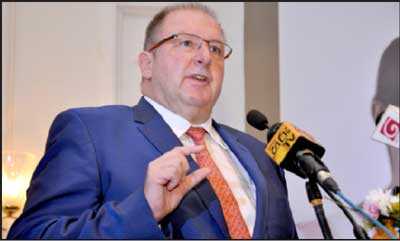Sunday Nov 09, 2025
Sunday Nov 09, 2025
Friday, 15 February 2019 00:06 - - {{hitsCtrl.values.hits}}
By Uditha Jayasinghe
Sri Lanka’s growth is expected to recover moderately to 3.5% in 2019, up from 3.1% last year, the World Bank said yesterday, but warned the country will face stiff headwinds from high debt repayments, difficult global environment, and possible political instability due to elections at home.
 |
World Bank South Asia Region Vice President Dr. Hartwing Schafer |
 |
World Bank Senior Country Economist for Sri Lanka and Maldives Dr. Fernando Im |
Releasing the latest Sri Lanka Development Update 2019, the World Bank said the economy is expected to rebound from a low base and move towards 4% in the medium-term, driven by domestic demand. Inflation will stabilise around mid-single digit level, although pass-through of currency depreciation and fuel prices would exert upward pressure. Primary surplus supported by the implementation of revenue measures will contribute to narrow the overall fiscal deficit to 4.7% of GDP by 2021.
The report observed Sri Lanka is stepping up to the plate at a time when the global environment remains turbulent. Key reforms, such as the implementation of the Inland Revenue Law, passing of the Active Liability Management Act, are helping to prepare for heightened external debt refinancing risks in 2019 and beyond.
“It is important to consolidate on previous reforms to ensure maximum benefits,” said World Bank Sri Lanka Senior Country Economist Fernando Im. He explained that future reforms could yield high development impacts, such as further strengthening public finance management and supporting the implementation of a social registry to improve coverage and targeting of social safety nets.
At an estimated 83% of its Gross Domestic Product, Sri Lanka’s central Government debt level is high. As the country approached upper middle-income status, it has been borrowing on more commercial terms with increased cost and risk.
The majority of foreign currency denominated debt is now largely made up of market borrowings, including International Sovereign Bonds (ISBs) and Sri Lanka Development Bonds (SLDBs), which in 2017 accounted for 53%, up from just 3% of total foreign currency denominated debt in 2000.
“In total, maturities of bullet repayments on Eurobonds from 2019 to 2023 and from 2025 to 2028 alone amount to $12.15 billion. This is new territory for the country, and could expose the island nation to refinancing risks,” the report added.
In response, the Government has adopted policies designed to address these risks; however, the slow progress of key structural reforms remains a cause for concern. It is hoped that improvements in debt management will help manage costs and risks of the portfolio, develop the domestic financial market and improve access to finance.
Continued fiscal consolidation, albeit slow, is projected to bring the public debt burden to a downward path at 79.2% of GDP by 2021. External current account deficit is projected around 2.4% of GDP between 2019-2021, as tourism receipts cushion sluggish remittance flows and high external interest payments. Foreign capital inflows to government securities and FDI inflows are expected to help closing the external financing. Reserve adequacy metrics will continue to be low as Sri Lanka raises funds mainly for refinancing Eurobonds.
Under the baseline scenario, central Government debt-to-GDP ratio is projected to come down to 79.2% of GDP by 2021. Fiscal discipline is even more important in an environment of high domestic interest rates and gradual tightening of global financial conditions amid currency depreciation.
“The challenging political environment has already slowed the reform agenda, and remains the key risk to a favourable medium-term outlook. On the fiscal and debt management front, risks include the delay or reversals in implementing revenue measures, slower than expected improvement in tax administration, increases in non-discretionary spending, and delays in implementing the liability management operations. The increasing occurrence and impact of natural disasters could have an adverse impact on growth, the government budget, the external sector and poverty reduction.”
External risks include disappointing growth in key countries that generate foreign exchange inflows to Sri Lanka: exports, tourism, remittances, FDI, and other financing flows. Tighter than expected global financial conditions would increase the cost of debt, and make rolling over the maturing Eurobonds more difficult, the report warned. Faster than expected rises in commodity prices would increase pressure on the balance of payments, and could make further price reforms such as energy more difficult.
A primary surplus of 0.8% of GDP is expected for 2018, after recording a small primary surplus in 2017 that came as a first in decades. The improvement was due to a combination of increasing tax revenues and tight expenditure control. Tax revenue is expected to have increased to 13.2% of GDP thanks to increased collection of motor vehicle excise tax, amid a sharp rise in motor vehicle imports in the first half of 2018, and increased income tax collection thanks to the implementation of new Inland Revenue Act.
The central Government debt to GDP ratio is expected to have increased to 83% by end-2018 due to the impact of currency depreciation and high real interest rates. Moreover, SOE debt (with or without guarantees from the Treasury), which is not included in the central Government debt, continues to remain high.